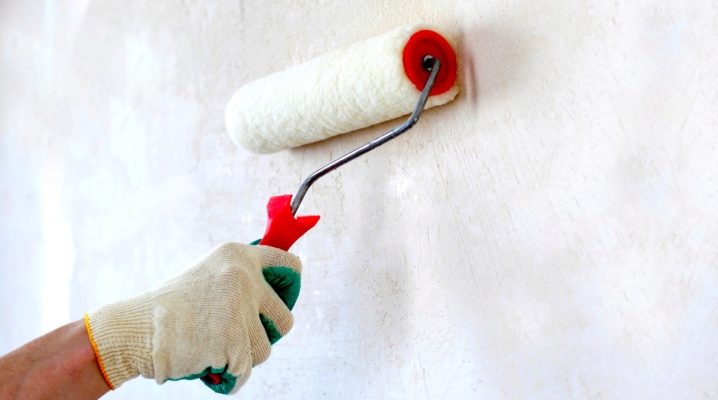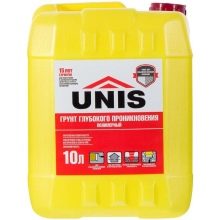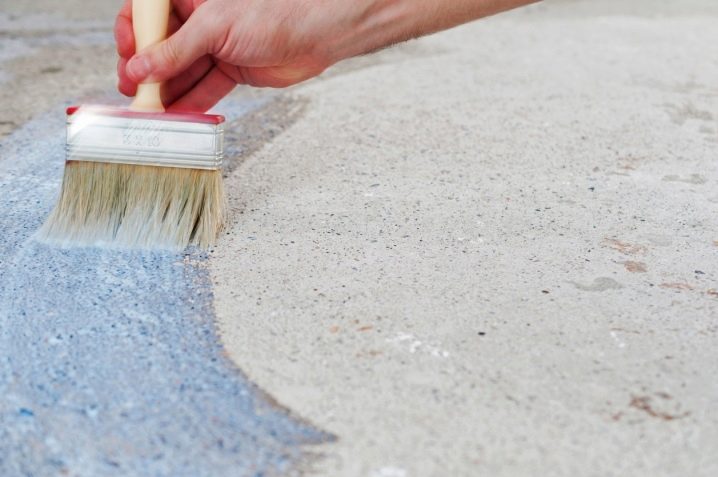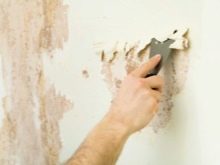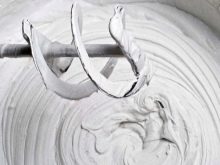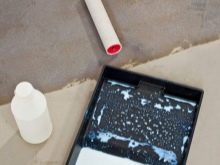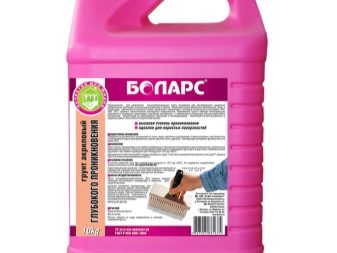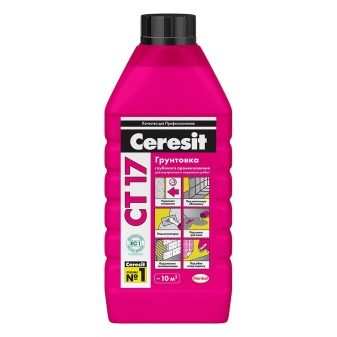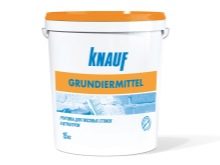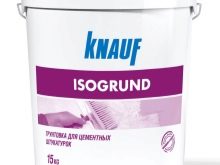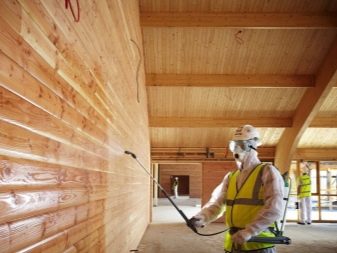Deep penetration primer: what it is and why it is needed
Priming the surface is a necessary step during the finishing works. Priming mixtures improve adhesion, in certain cases reduce the consumption of finishing material. In the market of building materials there are a lot of varieties of such solutions. Let us consider in detail what constitutes a deep penetration primer, for which it is necessary.
What it is?
Deep penetration primer designed for the treatment of porous surfaces. When applied, the mixture penetrates into the structure of the material to a greater depth, fills the pores and upon drying forms a protective film on the treated surface. Mixes of deep penetration often produce in accordance with TU 2316-003-11779802-99 and GOST 28196-89.Mortars are used for processing walls, ceilings and floors before further surface finishing.
Primer deep penetration produced in the form of:
- powdered substance that must be diluted before application;
- ready to use mixture.
Deeply penetrating into the structure of the material, this material makes the surface more durable. Due to it there is an increase in the level of adhesion. It reduces the porosity of the treated surface. Most of the compositions include special components, thanks to which the walls, floor or ceiling will be protected from the formation and spread of fungus, mold. Deep penetration primer reduces the consumption of paints and adhesives per square meter. On the primer layer, the decorative coating falls easily and evenly.
Specifications
Penetrating composition has a number of specific technical indicators.
Consider the main technical characteristics:
- Penetration depth The standard figure is 0.5 cm. For high-quality mixtures, the penetration depth can reach 10 mm.
- Material consumption can range from 50 to 300 g per square meter.It all depends on the particular type of primer and the type of surface being treated.
- Dry residue. The higher the value of this indicator, the more water can be used to dilute the soil without degrading its characteristics. After dilution of the mixture in water, the dry residue indicator should not fall below 5%.
- The drying time of the coating depends on the composition of the mixture. At a temperature of 20 degrees Celsius and a humidity of 70%, the average drying time can be from 1 to 3 hours.
- The operating temperature ranges from - 40 to + 60 degrees.
- The diameter of the particles of the mixture may be from 0.05 to 0.15 μm. The solution can be applied at a temperature of from 5 to 30 degrees.
Kinds
Depending on the composition of the primer mixture is divided into several varieties. Each species has its own distinctive features and properties. Consider the main types of deep-penetrating mixtures:
Acrylic
They are considered universal, as they are suitable for almost any material. These mixtures are characterized by good absorption and fast drying. The penetration depth of the solution can reach 10 mm. Great for walling before sticking wallpaper.
Silicone
This primer is used for external and internal work.Silicone compounds well strengthen the surface, have a water-repellent property. Silicone primer is suitable for treatment of the base for different types of finishing materials.
Alkyd
Alkyd primer is not recommended for treatment of crumbling surfaces (for example, plaster, gypsum). It is used more often to strengthen wood and metal. The mixture strengthens the structure and protects it from the formation of fungus, mold. This primer is well compatible with PVA, nitro-paints, alkyd paints and varnishes, and acrylic-based putty.
Polyvinyl acetate
Such primers are used exclusively for painting. They have a high drying rate and reduce the consumption of coloring mixtures.
Epoxy
These mixtures are used for processing metal and concrete. They improve the level of wear resistance of the coating.
Polystyrene
This primer is suitable for the treatment of wooden and plastered surfaces, it forms a moisture-resistant protective film. The disadvantage of this primer is a high level of toxicity.
Shellac
Shellac primers are used to treat wood surfaces,they penetrate deep into the structure of the material and strengthen its inner and outer layers, prevent the resin from exiting through the wood fibers to the outside. After drying, this primer forms a strong protective film on the surface. Sheeting film protects wood from moisture and decay processes.
Silicate
This primer is applied under silicate coloring mixtures. It forms a durable coating that has good vapor permeability and resistance to temperature extremes. Great for outdoor decoration.
Latex
Latex primer is made on the basis of water and polymers. With the help of this material, it is possible to hide the ingrained rust spots, soot and other types of dirt on the surface. Such primer is suitable for external and internal works.
Water dispersion
Water-dispersion primer is designed for exterior and interior use. Differs in frost resistance, high level of adhesion, protects the surface from environmental influences. A highly concentrated mixture can be diluted with water without losing the quality of its properties.
To destination
To give the soil additional useful properties, manufacturers add special ingredients to the mixtures. At their expense, the primer has a classification by purpose.
Antifungal
Antifungal mixture has protective properties against the formation of fungus and mold. Soil acquires such properties due to the fungicides included in its composition. Fungicides not only prevent contamination of the surface with fungus and mold, but also destroy the germs that have already originated. Such a composition is used for already infected surfaces.
Antiseptic
Its properties resemble anti-fungal mixture. The difference lies in the fact that antiseptic primer is used only to protect coatings from fungus and mold. Treat with primer with antiseptic can only non-infected surface.
Facade firming
Used for exterior wall decoration. Facade primer strengthens the walls, improves the water-repellent characteristics of the base.
For concrete
This primer makes the surface rough, improving adhesion. This primer is only suitable for interior decorating.
Priming mixtures have a difference in shades. Under any surface to be treated, you can choose the mixture that is most appropriate in shade, including the transparent variety. Under the wallpaper often applied white primer. This allows you to give the coating brightness, avoiding color distortion.
Scope of application
Deep penetrating mixtures are designed for different types of surfaces. Consider several types.
Wood
Wood surfaces are subject to external factors, they do not last long without quality processing and finishing. A mixture of deep penetration strengthens the structure of the material, increases the life of the wood. Antiseptics, which are included in most deep penetration soil formulations, will provide additional protection against mold and mildew.
Brick
Deep-penetrating mixtures strengthen the brick surface, which allows to extend the life of such a material. The properties of the composition make it possible to connect the surface with microcracks together.
Concrete
First of all, old concrete coatings need to be processed with deep penetration. Penetrating into the surface structure, the primer aligns it, binding the dust.
Surface plastered with cement
Soil strengthens the surface and prevents shedding. In addition, the mixture reduces the absorbency of the plaster.
Deep-penetrating mixtures are not suitable for all materials. Plasterboard surfaces are not recommended to be treated with this primer. High quality gypsum plasterboard has a strong structure, it does not need additional reinforcement. The structure of the material of poor quality can not be strengthened with the help of soil. A deep penetration primer is suitable for the treatment of surfaces with good absorbency. For this reason, it is inappropriate to use primer for metal substrates.
How to choose?
To the result of finishing work was high-quality and met your expectations, it is worth a responsible approach to the choice of primer. It is imperative to purchase a mixture of high quality. Cheap compounds will not provide adequate surface protection and good adhesion. Before buying, you should familiarize yourself with the most popular manufacturers and the composition of priming mixtures. When choosing a primer is worth considering a number of significant factors. Select the main.
Type of finishing
Initially, it is worth deciding what works the primer is intended for.The varieties for preparing the base indoors or outside are different. For exterior work it is better to use special facade mixtures that are frost resistant and moisture resistant. For interior work, you need to select a more environmentally friendly primer that does not contain toxins. To prepare surfaces in rooms with high humidity levels, you need to choose a primer with an antiseptic.
Surface to be treated
It is worth carefully studying the labeling: it must indicate for which specific types of foundation the composition is suitable (walls, floor, ceiling). The material on which the primer will be applied is different; you cannot use for processing the first thing you like in the shop window.
Further finish
The type of finishing works matters. Compositions for surface treatment for painting, tiling, finishing with decorative plaster and wallpaper are different.
Drying speed
For interior work it is better to choose mixtures that dry quickly. This will reduce the time to prepare the foundation.
Consumption
Primer consumption per 1 m2 depends on the type of material being processed, the composition of the mixture, the temperature conditions at which work will be carried out.Despite the fact that primer mixes of deep penetration are made on the basis of similar specifications and state standards, the soil compositions of different manufacturers may vary.
The approximate primer consumption per square meter is always indicated by the manufacturer on the package. In fact, it may differ: porous walls can be absorbed more when they are first applied. The proportions of the primer penetration of deep penetration are significantly different from the consumption of other types of priming mixtures. Basically, the range of consumption per square meter for applying one layer of deep-penetrating solution ranges from 80 to 180 g.
Application details
Handle the walls, floor or ceiling with a primer mixture with their own hands is not particularly difficult. The first stage of internal or external work is surface preparation. If it has a layer of old finish, it must be cleaned. Pieces of paintwork or plaster can be removed with a hard trowel. After the old coating is completely removed, the surface must be cleaned of dirt and dust. Wash the base under the ground can be cleaned with a damp cloth or a brush.
The next step is to prepare the solution. Detailed instructions for use of the mixture are on the package. If you purchased a liquid primer, such material is ready for use. Dry primer mixtures must be pre-diluted with water. The primer must be applied to the surface with a brush or roller.
Plots with a large area is better treated with an airbrush.
If the treated surface is smooth, it is more convenient to use a roller with a long pile. After carrying out priming work, it should dry well before further finishing.
Manufacturers and reviews
Before you buy a deep penetration primer for finishing work, it is recommended to get acquainted with the most well-known manufacturers and reviews of their products. Only high quality primer will strengthen the surface to be treated and facilitate the work on applying the topcoat. The rating of popular products includes products of several brands.
"Optimist"
The company produces a separate line of deep-penetrating primer coatings. Silicone deep-penetrating facade primer is used for outdoor work.It increases the level of moisture resistance of the base and stabilizes the vapor permeability, strengthens loose and fragile base.
Interior acrylic-based primer can be applied to the old layer of oil paint or alkyd enamel. It is suitable for priming the floor. The composition contains an antiseptic that prevents the occurrence of mold and mildew. This soil strengthens the structure of the treated coating.
Concentrated penetrant provides good adhesion. Forms a moisture-proof protective film on the surface. Buyers distinguish ease of application, good absorption, low solution consumption, short drying time. This primer mixture has excellent performance and high quality. Among the shortcomings of the material, buyers emit an unpleasant odor and too liquid consistency.
"Miners"
Deep-penetrating mortar “Prospectors” is applicable for external and internal works. It strengthens the base and reduces the consumption of paints and varnishes with further finishing. The composition of the primer solution includes antiseptic additives that protect the surface from the spread of fungus and mold.Feedback on this product is mostly positive.
Among the advantages of deep-penetrating soil "miners" emit:
- even and durable coating after application;
- Excellent value for money and quality;
- high drying speed.
Minor drawbacks include a slight odor, as well as the difficulty of removing the mixture from non-treating surfaces.
"Tex"
The company "Tex" produces a separate line of deep-penetrating primer mixtures. Two-in-one deep-penetrating mortar “Universal” is intended for application on a porous base before painting with water-dispersion mixtures, puttying, and finishing with tiled materials. Water-dispersion mixture "Economy" must be used for interior decoration. Can be used in rooms with high humidity levels. It is suitable as a cover for wallpaper. Deep-penetrating solution "Optimum" can be used for interior and exterior decoration, it improves adhesion, reduces the consumption of paints and varnishes with further finishing.
Feedback on the product brand mostly positive.
Buyers have the following features:
- low cost;
- good quality;
- short drying time;
- good adhesion;
- strengthening the surface structure;
- good absorbability.
A minor drawback of some customers consider the unpleasant smell of the solution.
"Bolars"
The company "Bolars" produces high-quality materials for professional construction with modern high-tech equipment. This company has in its arsenal its own scientific laboratories to determine the quality of raw materials and finished materials. Soil of deep penetration "Bolars" strengthens the structure of porous surfaces, improves adhesion and reduces the consumption of paints and varnishes with further finishing. The primer mixture "Bolars" has proven itself in the market of building materials, has only positive customer reviews. Consumers note a small consumption of the mixture, quick drying.
Lacra
The company "Lacra" produces paint products using modern technology. The products of this company are of high quality and environmental friendliness. The primer of deep penetration "Lacra" is available in three versions, including interior primer with additives against mold, similar to acrylic-based and universal with additives against mold.
The most demanded interior mix with additives against mold and universal primer. These materials have only positive feedback.
Consumers highlight the following advantages of the soil "Lakra":
- low cost;
- durable coating;
- high quality;
- saving paint and glue mixtures;
- good surface reinforcement.
Ceresit
Ceresit independently conducts research and development and develops unique technologies for the manufacture of finishing materials. The primer of deep penetration Ceresit CT 17 is one of the most popular primers on the market.
Buyers highlight the following product benefits:
- suitable for all types of absorbent surfaces;
- has a short drying time;
- easy to apply;
- high quality;
- increases adhesion level;
- strengthens the surface structure;
- binds dust;
- reduces surface absorption;
- reduces the consumption of paints and varnishes with further finishing;
- economical to use.
Among the disadvantages are the high cost of the material and unpleasant smell.
Knauf
Knauf - the largest manufacturer of building materials, known throughout the world. The company manufactures high quality eco-friendly materials. Knauf-Tifengrund, a reinforcing deep-penetrating primer, is made on the basis of a polymer dispersion. This mixture is suitable for interior and exterior use. Buyers note the high quality of Knauf-Tiefengrund material and an acceptable price. Other advantages include good adhesion and high drying rates. Deficiencies buyers have not identified.
"Descartes"
The products of the Descartes company manufactured by the Expert brand are in great demand on the Russian market. Expert deep-penetrating solution is made on an acrylic base from imported high-quality raw materials. This material is suitable for internal and external preparatory work. It is applied before painting or filling the surface. Buyers note a good level of adhesion, this primer reduces surface absorption. Despite the fact that the soil "Expert" copes with the main tasks, consumers talk about the low quality of the mixture.
Axton
Axton offers a wide range of primers. Axton latex deep penetrating blend is designed to improve adhesion and strengthen the base structure before finishing. Buyers note the ease of applying the mixture, improving the adhesion of the surface to other materials and the low cost of the material. The minor cons of the solution include an unpleasant odor.
"Founds"
The company "Osnovit" is one of the leaders in the production of dry finishing mixtures in Russia. The company develops its own unique technology of building materials. Quality control is not only finished products, but also raw materials used in the production of primer. Deep-penetrating mixture "Foundations Dipont LP53" can be used for external and internal repair work. The mixture is designed to strengthen the old fragile surfaces that have a loose structure. Buyers note a good level of adhesion of the treated base and a small consumption of primer mixture.
Unis
Unis has been manufacturing materials for repair and construction since 1994.The company offers a wide range of ready mixes for finishing and construction work. The recipe for the manufacture of building materials is developed on the basis of its own research and development center. Unis products have good technical characteristics and meet high international standards.
Unis deep-penetrating primer can be used for exterior and interior in dry, unheated and wet areas. The mixture strengthens the old and loose grounds, promotes good adhesion.
Buyers highlight the following product benefits:
- good adhesion;
- low mixture consumption;
- high drying speed;
- no unpleasant smell;
- good absorbability;
- even coating
Useful recommendations
Some deep-penetrating primer mixes contain harmful substances and are toxic.
During the work with these solutions it is necessary to follow safety measures:
- Soil dries the skin, so you should avoid getting the mixture on the leather integument. Work must be carried out in protective clothing. Hands must be protected with gloves.
- Use a respirator or mask to protect the respiratory system from harmful vapors.If finishing work is carried out indoors, care must be taken to thoroughly ventilate the room.
- To protect the mucous membrane of the eyes, you must use special construction glasses.
- If it is necessary to treat a surface with a dense structure with a primer mixture, it is better to use concrete contact. It consists of quartz sand, which provides good adhesion.
For how to prime the wall, see the next video.
